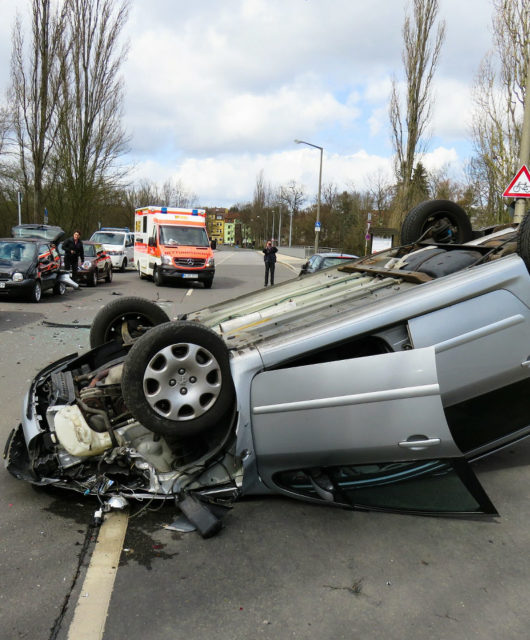A Look at the Latest Car Safety Technology
 It was Volvo who in 1959 invented the three-point seatbelt, an invention that is thought to have saved the lives of millions of people involved in crashes. Car companies ever since have been funding new car safety research and innovation, constantly vying to be at the forefront when it comes to making drivers feel secure behind the wheel. This has been an ongoing process that has seen many new technologies developed, giving car brands an initial market lead before, inevitably, the technology becomes standard across the industry.
It was Volvo who in 1959 invented the three-point seatbelt, an invention that is thought to have saved the lives of millions of people involved in crashes. Car companies ever since have been funding new car safety research and innovation, constantly vying to be at the forefront when it comes to making drivers feel secure behind the wheel. This has been an ongoing process that has seen many new technologies developed, giving car brands an initial market lead before, inevitably, the technology becomes standard across the industry.
The vast majority of new cars are tested by Euro NCAP (European New Car Assessment Programme), which is an independent organisation that performs a range of crash tests and rates each new car to appear on the market. Strong performance in such a test is usually the clearest indicator that a particular technology has lifesaving potential. It is usually not long before a new technology rated by the Euro NCAP inspires a host of imitations; no car brand wants to be thought of as less safe than any others. If a new technology is sufficiently effective, it might even become industry standard, and then even legally required for all new cars. Such is how this technology proliferates.
The car industry is perhaps the industry within which most people are aware of the innovative technologies being developed. Cars are, of course, ubiquitous and while it’s not quite true that everyone you meet will own a car, it is certainly the case that everyone you meet will have used one – and often.
Thus, headline-grabbing innovations such as the concept of driverless cars have captured the imagination of this generation just as the futuristic prospect of flying cars captured the imagination of (slightly too optimistic) previous generations. When it comes to cars, everyone looks towards the future and car brands frequently work this into their advertising. And yet, the road towards the crash-free driverless utopia is paved with a host of smaller, less flashy innovations being periodically developed and making car travel that little bit safer with each passing year.
Most car safety technology can be grouped into certain categories. There are reactive and responsive features, such as adaptive cruise control and the anti-lock braking system; there are automated systems, which can be anything from automatic lights to automatic parking; and there are those technologies concerned with the driver’s view, such as rear alarm systems and electronic stability control (ESC). These car safety technologies often work in tandem with constantly improving road and traffic technologies involving everything from special vehicle designated lanes to the humble traffic light or spray line marker machines. Automobiles have the potential to be very dangerous things, so there is an entire system of safety built up around them.
With that in mind, we will look at the latest car safety technologies currently making an appearance in the latest automobiles on the market. Many of these technologies are nothing short of lifesaving and can be expected to become only more commonplace as time goes on.
Table of Contents
Adaptive Cruise Control
Cruise control is defined as a system that automatically controls the speed of a motor vehicle, and it is certainly nothing new. It sounds hard to believe, but a very early form of mechanical cruise control existed in the very earliest cars back in the early 1900s. This technology made use of a lever on the steering column so the driver could set the speed to be maintained by the engine. In modern parlance, however, cruise control refers much more often to electronic automatic systems that make use of sensors to not only maintain a steady speed but to also react to everything from upcoming corners, other vehicles, and traffic lights.
So called adaptive cruise control not only maintains a specific speed but can also adjust it. This can ensure a safe following distance behind other cars on the motorway. Some adaptive cruise control systems can even trigger emergency breaking if a collision seems likely.
Adaptive Headlights
Applying the same system of sensors that are used in adaptive cruise control systems, adaptive headlights can react to a vehicle turning in order to keep lights focussed on the road ahead at all times. This is massively useful for night-time visibility on curved roads, where a car’s turning motion is in danger of briefly causing blind spots on the road immediately ahead.
Related to adaptive headlights is so-called “automatic lights” technology. This is a very useful safety feature for when cars driving during the day may encounter temporary darkness, most often when travelling through a tunnel. Removing the requirement for a driver to manually turn on the lights upon entering a tunnel and then turn them off again upon exiting it, automatic lights ensure there is no temporary darkness and no need for a driver to briefly lose focus on the road.
Automatic Parking
Truly at the cutting edge of technology, automatic parking is the technology which, upon being activated, can control your car into the tightest of parking spots by means of precisely calculated angles and distances. These are essentially an updated form of park-guide systems, which employ the same sensors but only indicate to the driver how to park. New automatic parking technology can actually park the car itself.
Lane Departure Warning and Lane Keeping Assist
Lane Departure Warning and Lane Keeping Assist are technologies designed to prevent cars from drifting out of road lanes without the driver indicating. The difference between them is similar to that between the different automatic parking systems. Lane Departure Warning will detect when a car is exiting its lane while Lane Keeping Assist will actively counter-steer in order to correct the drift before it becomes a problem. Both are massively useful technologies that provide a good countermeasure to driver fatigue in the most perilous of driving situations.
Driver Fatigue Alert
The technologies designed to alert drivers to their own fatigue vary massively and can involve something as simple as a timed alert to remind the long-haul driver to take a break or something much higher tech. At the cutting edge of this technology is that currently found in Subaru’s driving monitoring system, which uses a camera and facial recognition technology to alert the driver when their gaze has wandered or if their eyes are closing, triggering an alert when this happens. Vauxhall’s driver drowsiness alert triggers warnings if the car veers in such a way as to suggest fatigue or inattention.
Car safety features are advancing along with the relentless pace of car technology in general, and what is now cutting edge could easily be industry standard before long. Time will tell if any of these new technologies can have an appreciable effect on the general safety of motorists.









